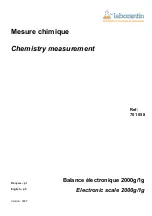
Deadweight Tester / Pressure Balance
GB
LR-
Cal
LDW-H
Operating Instructions
LR-
Cal
LDW-H
9
2.2 Basic principle of the Pressure Balance
.
Their operating principle is based on the physical definition of pressure, the quotient of force and area.
Area
Force
essure
Pr
The key element of the pressure balance is a precision-manufactured piston/cylinder system with a
precisely measured cross-sectional area.
To apply a pressure charge to the system, the piston is placed under a load with (calibrated) weight
pieces.
Each mass from the set of weights is identified by a nominal weight, which generates a pressure value
in the system (assuming standard reference conditions). Each weight has a number and in the
calibration certificate describing the mass value to each weight with its resultant pressure value. The
weights are chosen according to the desired pressure value.
After that, the integrated spindle pump increases the pressure until the weights are in a floating state.
2.3 Environmental factors
.
The piston pressure gauge is calibrated to standard reference conditions when it leaves the factory
(depending on customer specifications).
If there are significant deviations between the application conditions and the defined reference
conditions, appropriate corrections must be made.
Following are the main factors that enter into play and must be considered.
You can download a free of charge MS Excel sheet for making recommended correction
calculations:
https://www.druck-temperatur.de/images/software/dwt-corrections.zip
2.3.1 Local fluctuations in gravity-value
.
The local force of gravitation is subject to major fluctuations caused by geographical variation.
The value may differ from one place on earth to another by as much as 0.5 %. Since this value has a
direct effect on the measurement, it is essential that it be taken into consideration.
The weight pieces can even be adjusted during manufacturing to match the location where they will be
used. Another option, especially if the device will be used at multiple locations, is to perform a
calibration to the standard gravity,
"Standard-g = 9.80665 m/s
2
".
Then a correction must be performed for each measurement according to the formula below:
g
dard
S
site
n
Applicatio
g
pressure
True
tan
value
Nominal
Example:
Local gravity set during manufacturing:
9.806650 m/s
2
Locale gravity at application site:
9.811053 m/s
2
Nominal pressure: 100 bar
True pressure:
bar
bar
g
g
p
p
dard
S
Local
0449
.
100
80665
.
9
81105
.
9
100
tan
Nominal
Without the correction, measurements would differ from the nominal applied pressure by 0.05%.










































